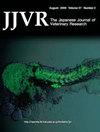小隐孢子虫1型病毒高灵敏检测方法的建立
IF 0.3
4区 农林科学
Q4 VETERINARY SCIENCES
引用次数: 1
摘要
隐孢子虫是一种复杂的人畜共患寄生虫,感染大多数哺乳动物,包括人类。细小隐孢子虫病毒1型(CSpV1)是Partitiviridae家族中第一个被识别感染原生动物宿主的成员。已经尝试了基于CSpV1检测的隐孢子虫追踪;然而,每项研究都对PCR方案、引物和靶病毒序列使用了不同的条件。因此,基于PCR的CSpV1检测的灵敏度仍不清楚。此外,由于目前使用的纯化方法卵囊数量少、样品降解和产率低,从临床样品中纯化卵囊可能存在问题。在这里,我们表明,通过使用半嵌套PCR技术,可以从各种类型的临床样本中检测dsRNA2编码区的后半部分,而不需要纯化卵囊。此外,我们发现本研究中靶向的短序列比隐孢子虫GP60基因具有更高的多样性。总之,我们的发现表明,这种方法可以作为隐孢子虫物种的重要跟踪标记。本文章由计算机程序翻译,如有差异,请以英文原文为准。
Development of a highly sensitive method for the detection of Cryptosporidium parvum virus type 1 (CSpV1)
Cryptosporidium is an apicomplexan zoonotic parasite that infects most mammals, including humans. Cryptosporidium parvum virus type 1 (CSpV1) is the first member within the Partitiviridae family recognized to infect protozoan hosts. Cryptosporidium tracking based on CSpV1 detection has been attempted; however, each study used different conditions for the PCR protocol, primers, and target viral sequences. Accordingly, the sensitivity of PCR-based CSpV1 detection remains unclear. In addition, oocyst purification from clinical samples can be problematic due to small number of oocysts, sample degradation and low yield efficiency of currently used purification methods. Here we show that the second half of the coding region of dsRNA2 can be detected from various types of clinical samples, without the need for oocyst purification, by using a semi-nested-PCR technique. Furthermore, we show that the short sequence targeted in this study has higher diversity than the Cryptosporidium GP60 gene. Taken together, our findings suggest that this method could be used as an important tracking marker for Cryptosporidium species.
求助全文
通过发布文献求助,成功后即可免费获取论文全文。
去求助
来源期刊
CiteScore
1.00
自引率
0.00%
发文量
0
审稿时长
>36 weeks
期刊介绍:
The Japanese Journal of Veterinary Research (JJVR) quarterly publishes peer-reviewed articles on all aspects of veterinary science. JJVR was originally published as a “University Journal” of veterinary science at Hokkaido University from more than 60 years ago. Currently, JJVR, is Japan’s leading scientific veterinary journal, and provides valuable information for the development of veterinary science by welcoming contributions from researchers worldwide.
JJVR offers online submission for Regular Papers, Short Communications, and Review Articles that are unpublished and not being considered for publication elsewhere. Research areas include:
Anatomy, Physiology, Biochemistry, Pharmacology, Microbiology, Infectious diseases, Parasitology, Laboratory Animal Science and Medicine, Internal Medicine, Surgery, Pathology, Theriogenology, Molecular Medicine, Public Health, Radiation Biology, Toxicology, Wildlife Biology and Medicine, Veterinary Hygiene, The other fields related to veterinary science.

 求助内容:
求助内容: 应助结果提醒方式:
应助结果提醒方式:


